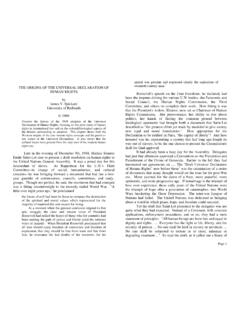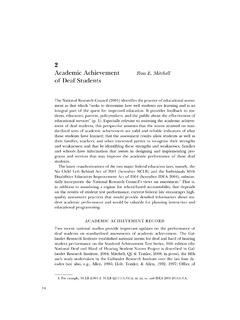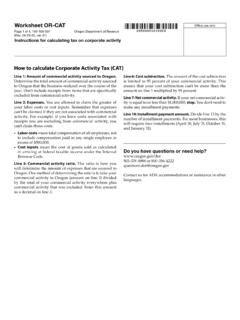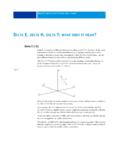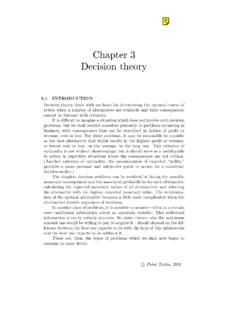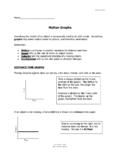Transcription of Chapter 6: THE UNCERTAINTY OF THE MEAN
1 6. UNCERTAINTY of the Mean 65 Chapter 6: THE UNCERTAINTY OF THE MEAN Now, for instance, it was reckoned a remarkable thing that at the last party in my rooms, that upon an average we cleared about five pints a head. --- Northanger Abbey USING A SET S MEAN AS A BEST GUESS Imagine that we are doing an experiment, and we want to make the best possible guess as to the true value of a quantity whose measured values are subject to some kind of random error, either due to human estimation error (as in the case of the stopwatch measurements in the speed of sound lab) or random perturbing physical effects (noise), or both. In order to get a sense of the UNCERTAINTY of the measurement, you have already taken N individual measurements of the quantity. If the effects that perturb the measured value away from its true value are truly random, then they are equally likely to cause any given measured value to be higher than the true value as they are to cause it to be lower than the true value.
2 This means that if you take a set of N measurements of the same quantity and those measurements are subject to random effects, it is likely that the set will contain some values that are too high and some that are too low compared to the true value. If you think of each measurement value in the set as being the sum of the measurement s true value and some random error, what we are saying is that the error of a given measurement is as likely to be positive as negative if it is truly random. One way to get a good estimate of the true value of a quantity is therefore to calculate the mean (average) of the measurement values in the set. When you calculate the mean of a set of measurements, you sum the measurements and then divide by N, the number of measurements in the set. If we imagine each measurement to be equal to the true value plus some random error, then the sum of N measurements will be equal to N times the true value plus the sum of all the random errors.
3 Since the random errors are as likely to be negative as positive, they will tend to cancel each other out when summed, meaning that the sum of N measurements is likely to be very close to N times the true value. Dividing the result by N to get the mean thus yields a number that is likely to be close to the true value. The mean thus represents a better guess as to a quantity s true value than any of the individual values in set of measurements. The assumption that the errors cancel each other out gets better and better as the number of measurements in the set increases. For example, if there are only three measurements in a set, there is one chance in eight that all three measurements are too high, implying that the mean of these measurements will not be a good estimate of the quantity s true value. As the number of measurements in a set increases, though, the probability that there is an approximately even mix of measured values in the set that are too high and too low becomes larger and larger.
4 6. UNCERTAINTY of the Mean 66 THE UNCERTAINTY OF THE MEAN The mean of any finite set of measurements is not going to be exactly equal to the quantity s true value: the random errors are not likely to perfectly cancel (especially if the number of measurements is relatively small. Saying that the mean is a better guess than any single given measurement is essentially saying that the UNCERTAINTY range of the mean is smaller than the UNCERTAINTY range of any given single measurement. But how much smaller is it? How can we quantify the UNCERTAINTY of the mean of the set of measurements? We define the UNCERTAINTY of the mean Um of a set of N measurements to be that value such that we are 95% confident that Um encloses the true value of the measurement (where x is the mean of the set). If were to take enough data so that we have many sets of N measurements, (as we did in the Inertial Mass lab), then this definition means operationally that if Um has the correct value, the range Um should enclose the true value for 95% of the sets means.)
5 According to the mathematicians, we can estimate the UNCERTAINTY Um of the mean of a normally distributed set of measurement using just one set of N measurements as follows: Ntsm U ( ) where s is the standard deviation of the set and t is the Student t-factor. In the UNCERTAINTY of the Mean lab, you should have verified that this expression was at least approximately consistent with the definition of UNCERTAINTY just described. Note that the estimate of the UNCERTAINTY of the mean given by equation has two properties that we know (or at least intuitively expect) to be true. First, it implies that the UNCERTAINTY of the mean is indeed smaller than the UNCERTAINTY of a single measurement (by the factor N/1), as we would expect from the argument given in the previous section. Second, the more measurements we take, the smaller Um becomes, implying that the mean becomes a better estimate of the measurement s true value as the number of measurements it embraces increases (as we should expect).
6 ESTIMATING UNCERTAINTIES FROM THE RANGE Calculating uncertainties of the mean through the standard deviation can quickly become very tedious, particularly when an experiment involves a number of sets of measurements. It would be nice to have a method that allows us to determine the UNCERTAINTY of the mean of a set of measurements at a glance. Here is such a method. The first step is to compute the range R of your set of data, which is defined to be the largest value minus the smallest value in your set. (You can often compute R to one or two significant digits in your head.) Then look in Table for the number N of the measurements that you took. An estimate of the value of the UNCERTAINTY (expressed as a multiple of R) appears in the next column, and again, you can probably do the multiplication (to one or two significant digits) in your head. For example, if you have 10 measurements of a period of 6.
7 UNCERTAINTY of the Mean 67 time ranging from s to s, the range is s and the UNCERTAINTY of the mean of these measurements is (according to the table) Um = = ( s) = s. Easy! The downside is that the value one reads from this table is only an estimate of the value that we would get by calculating Ntsm/ U, and not a particularly great one for small N, because it turns out that when N is small, the range of a set of measurements fluctuates from one set to another even more than the calculated value of s does. Still, if we are after a quick and dirty estimate that is still good to about one significant digit, this method is hard to beat. We will call this method the range method of determining the UNCERTAINTY of the mean and the method of directly computing the UNCERTAINTY of the mean using Ntsm/ UmTABLE ESTIMATING FROM THE RANGE N UmUm N 2 10 3 15 4 20 5 25 6 30 7 40 8 50 9 U the formal method.
8 You may freely use the range method for quick estimates and for checking formal calculations, but you should be sure to use the formal method when doing the final calculations that you will report in an analysis summary or full report. REPEATABLE AND UNREPEATABLE MEASUREMENTS The discussion in the previous sections suggests that if you want to determine a measured value as precisely as possible, it is better to take a set of measurements of that quantity and compute the mean than it is to take just one measurement. IMPORTANT: In this lab program, when a measurement is repeatable, you should always (automatically!) take a set of four to twenty measurements of the quantity in question, compute the mean of the set to get a best guess for the measurement value, and then compute the UNCERTAINTY of that mean. But when is a measurement repeatable ? There are three different kinds of measurements that are not repeatable.
9 The first are intrinsically unrepeatable measurements of one-time events. For example, imagine that you are timing the duration of a foot-race with a single stopwatch. When the first runner crosses the finish line, you stop the watch and look at the value registered. There is no way to repeat this measurement of this particular race duration: the value that you see on your stopwatch is the only measurement that you have and could ever have of this quantity. In the second category are subjectively influenced measurements where a subjective human judgment is required to make the measurement and such a judgment can be influenced by knowledge of past results or what the answer should be. In such cases, while we can technically repeat the measurement process, our knowledge of previous results, or our expectation of a certain outcome influences our judgment to such an extent that we cannot be sure that those measurements will remain randomly distributed.
10 For example, imagine measuring 6. UNCERTAINTY of the Mean 68 the size of an object using a ruler. The first measurement that you take of this quantity may be subject to random effects (for example, the way that you line up the ruler on the object, the orientation of your eye with respect to the ruler, and so on). The second and subsequent measurements that you take of this quantity will be strongly influenced by your knowledge of the first value that you obtained. It is very difficult to be completely unbiased about such measurements after the first, particularly when it comes to reading linear scales; after reading it once, it is hard to avoid looking at the scale the same way subsequently. This is not generally a problem with digital readouts (where you do not make a subjective judgment about the measurement) or when the random influences overwhelm the influences of subjectivity. For example, if you are using a gauge to read the pressure of steam in a boiler and clearly the reading is fluctuating from moment to moment by substantially more than one division on the scale, your memory of a previous measurement is not likely to have much influence on subsequent measurements.
